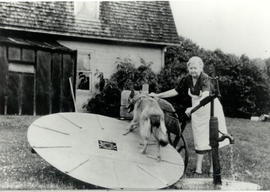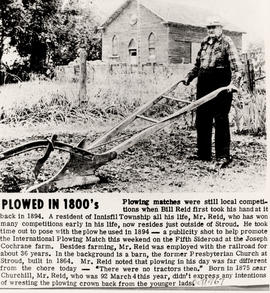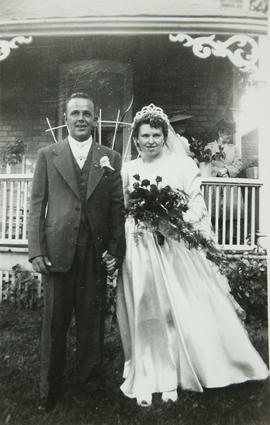- CA BWGPL PH25596
Municipality :
Community : Bradford West Gwillimbury
Lot :
Concession :
Description : Holland-Bradford Marshes
The Holland Marsh is perhaps the best known organic soil area in Ontario since it has been used for different purposes from the early days of settlement.
The Marsh is situated on the southern end of Lake Simcoe and was probably at one time, a bay extension of an ancient lake called "Algonquin". It is also the point at which the Holland River enters the Lake.
Part of the Holland River serves as a drainage channel for farms in the southern end of the Marsh.
History
The history of this marsh in short as as follows:
A glacial lake called Lake Algonquin covered the area about 10,000 years ago. The retreating glacier uncovered a lower outlet and at that time Lake Algonquin came to an end. The lake level dropped and left the Holland Marsh embayment dry.
As the land rose higher in the north than in the south, Lake Simcoe, which existed as a separate lake by this time, expanded and flooded the land south of Cook's Bay.
This flooding caused swampy conditions and the accumulation of organic matter such as muck and peat in the Marsh.
The organic accumulation varies from a few centimeters to as much as 27 meters and is underlain by fine sand, silt or clay.
The Marsh, approximately 3 km in width, extends 24 km inland from Cook's Bay.
The western border of the Marsh is mainly Schomberg clay, silt and sand deposits, whereas the eastern border is mainly till deposits (moulded mass of clay, sand, pebbles and boulders deposited by glaciers) with minor areas of Lake Algonquin sediments.
Drainage Schemes
Some 2900 ha (7200 acres) south and west of Highway 11 have been incorporated in the Holland Marsh Drainage Scheme constructed as diked areas under the Municipal Drainage Act, in the period 1925 to 1930.
Areas to the north of Highway 11 on each side of the river were developed later by private enterprise of individuals. Approximately nine or ten separate drainage systems have added another 1600 ha (4000 acres) of vegetable producing soil which is mainly between Highway 11 and Cook's Bay, some in the Cookstown area and some south-east of Alliston.
Abotu 800 ha (2000 acres) of the remaining peat and muck area have been or are being acquired by the Ontario Ministry of Natural Resources for a wildlife preservation area.
The scheme for draining the Marsh was promoted by Mr. W.H. Day, Professor of Physics at the Ontario Agricultural College, Guelph, to address a group of itnerested people on marsh drainage in December, 1909.
Until this time, the area was only known as a "mere ditch, swarming with bullfrogs and water snakes" -- so John Gait, an agent for the Canada Company described it in 1825.
Professor Day tested the soil and became enthusiastic about the possibilities of growing vegetables on it and actively promoted the scheme to drain all of the area. The implementation of the project was slowed by years of political maneuvering and the economic hardships of World War I, but in 1930, the Project was completed.
In 1930, Professor Day also reported a profit of $27,000 on his first crop of 15 ha (37 acres) of vegetables.
In 1931, some Dutch settlers had come to the marsh and by their industrious labours had achieved greater success than most. The Canadian representative of the Netherlands Emigration Foundation, Mr. J.J. Snor, saw a chance here for the rehabilitation of Dutch immigrants who had failed elsewhere in Ontario.
In 1934, eighteen Dutch families on relief were moved to this location from Toronto-Hamilton area. Each family received $600.00 (to be shared equally by the federal and municipal governments). The sum of $475.00 was to be repaid eventually by each family. The Dutch government contributed the $200.00 portion which was due by the municipality, when it was unable to produce this amount.
These eighteen original families formed the nucleus of the first settlement in the Marsh and it was and still is called "Ansnorveldt". After the war, more immigrants from the Netherlands came to settle here as well as people from practically every country in Europe.
There are large groups of Hungarian, German, Polish, Czechoslovakian, Ukrainian, and Italian immigrants as well as Portugese, Chinese and Japanese nationalities making their living from growing Marsh vegetables.
Organic Soils - A Disappearing Resource
An organic soil such the one in the Holland-Bradford Marshes is usually called on a pear or muck soil. It is estimated the Canada has approximately 1.3 million km square (500,000 square miles) of organic soils or in other words for every 7 ha (17 acres) of mineral soil, there is on ha (2.47 acres) of organic soil in Canada.
In recent years, Canadians are becoming much more aware of the need to take stock of Canada's resources and to use them wisely.
Organic soils are one of many irreplaceable Canadian natural resources. These soils were formed by nature under conditions of poor drainage and flooding. There formation takes place where plant materials (reeds, sedges, cat tails, bullrushes, mosses, shrubs, trees etc) gradually decompose but accumulate faster than the natural processes of decay are able to proceed.
It takes nature about 500 years to produce 30 cm (one foot) of organic soil. However, as soon as organic soils are drained and reclaimed from nature's water bound grasp, the undeniable fact is, that these soils start to disappear.
This disappearance or subsidence, the gradual loss of surface elevation, has been a chronic problem wherever organic soils have been reclaimed for agriculture. It is a natural process, which cannot be stopped if these soils continue to be used to grow crops. The rate of subsidence for average conditions varies from 1.13 cm per year, depending on water and farm management practices.
Several factors influence the rate of subsidence. Included in this list are: Height of water table, Oxidation, Compaction, Burning, wind, and Water Erosion, Shrinkage and Dehydration.
The Holland-Bradford Marsh, through proper water and farm management has about 40 to 50 years left until most of the 90 to 120 cm of muck and peat will have disappeared.




